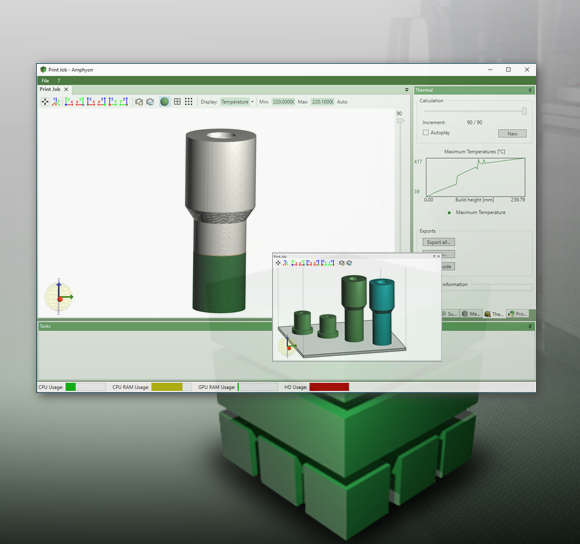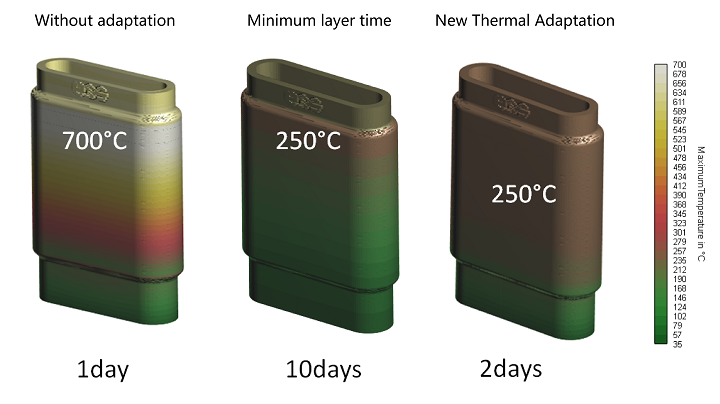German AM software provider Additive Works offers simulation-based process preparation solutions for laser beam melting (LBM) technology through its Amphyon software. Structured along the company’s “ASAP” principle of Assessment, Simulation, Adaption, and Process, Amphyon has multiple modules, including a new Thermal Adaption Module for job preparation in Amphyon 2021, the latest version of the simulation software suite for powder bed LBM printing.
“In addition to many other enhancements of Amphyon 2021, such as an improved material handling, the new Thermal Adaptation Module is a game changer. Ensuring thermally stable LPBF processes without sacrificing lead times to a fixed minimum layer time will expand the boundaries of AM business cases,” explained Dr. Hongxiao Xu, CTO at Additive Works.
In laser powder bed fusion (LPBF) 3D printing, a metal powder part is built up by the selective melting of a geometry’s cross sections in layers. The temperature could rise high and fast as the component gets taller, depending on several build factors such as nesting, process parameters, and geometry, and that could cause the part to have low quality; definitely a problem for large and multi-laser systems that quickly send a lot of energy into a part. So in order to achieve repeatable, reproduceable results, operators need to slow down the 3D printing process…once they figure out the correct temperature range and how long they need to wait, of course.
Amphyon 2021’s new Thermal Adaption Module for job preparation uses thermal process simulation data to help users solve these common issues that result from rising temperatures during LBM printing. The module ensures thermal stability during the process by adapting layer times. Using fixed minimum layer times will solve the problem, but it slows everything down too much, which increases the job time and, ultimately, the cost. Amphyon’s simulation can be applied here so users can determine the necessary waiting time for each layer, rather than setting a blanket waiting time for the whole build; this will majorly decrease the length of the print.
In this new module, users can set a target temperature before beginning print simulations, using the software suite’s thermal optimization and simulation abilities. This will cause the build rates to automatically adapt to this pre-set target, and keep temperatures from rising too high. Instead of wasting time with a trial and error process, Amphyon’s new Thermal Adaption Module uses a virtual approach, based on physics, to calculate the exact wait time for each layer of a build. This means that the added time per layer will correlate specifically with how long it takes the temperature to make it down to the initial target; however, in layers where there typically isn’t much overheating, like near the base plate, no extra time is needed.
The Thermal Adaption Module first analyzes the setup of the print job, learning the estimated build time and thermal behavior, as well as determining any process phases with especially high build rates. Then, the software identifies process parameters by comparing different machine settings, and finding the appropriate nesting and minimum layer time needed for thermal stability. It identifies any critical areas by analyzing the macroscopic thermal field, determining where extra supports might be needed, and then rapidly predicts the target temperatures by running various setups and calculating on GPUs or CPUs. This new module also features experimental calibration, so it can avoid unknown, difficult model parameters, and easily improve any presets if the measurements for them already exist.
It’s easy to see how advantageous this solution is for thin parts with very large features in the upper regions. For example, if a part like this needs to heat up to 700°C for a 21-hour print job, but there needs to be a minimum layer time so everything stays below 250°C, you could determine that the build will take approximately ten days. But using the simulation offered in Amphyon 2021’s Thermal Adaption Module, this time goes down to less than three days, but with an equal result. The initial calculation process will take twice as long, but, according to Additive Works, “the duration to obtain a component of optimal quality is reduced by factor 4.”
(Source/Images: Additive Works)
Subscribe to Our Email Newsletter
Stay up-to-date on all the latest news from the 3D printing industry and receive information and offers from third party vendors.
You May Also Like
3D Printing News Briefs, April 13, 2024: Robotics, Orthotics, & Hypersonics
In 3D Printing News Briefs today, we’re focusing first on robotics, as Carnegie Mellon University’s new Robotics Innovation Center will house several community outreach programs, and Ugogo3D is now working...
Rail Giant Alstom Saves $15M with 3D Printing Automation Software 3D Spark
3D Spark has entered into a three-year deal with the rail giant Alstom. Alstom, a transport behemoth with annual revenues of $16 billion, specializes in the manufacture of trains, trams,...
Meltio Expands Global Reach with New Partnerships in the Americas and Europe
Spanish 3D printing manufacturer Meltio has expanded its sales network across the globe. With the addition of three new partners in the United States, Brazil, Argentina, and Italy, Meltio aims...
3D Printing Webinar and Event Roundup: April 7, 2024
Webinars and events in the 3D printing industry are picking back up this week! Sea-Air-Space is coming to Maryland, and SAE International is sponsoring a 3D Systems webinar about 3D...


































